RNAS Stations around the Forth in WWI
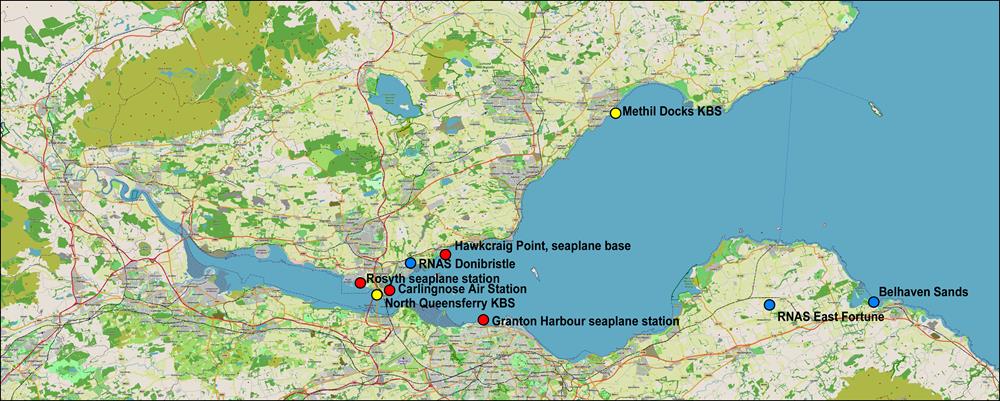 WWI Naval Airbases around the Forth
WWI Naval Airbases around the Forth
Seaplane Stations
Kite Balloon Stations
RNAS Donibristle – naval aircraft maintenance station
RNAS East Fortune – coastal patrol station
Belhaven Sands – torpedo practise
Seaplane Stations
The first military airbase in Scotland was created in 1912 at Carlingnose Air Station, on Port Laing beach in North Queensferry for what would eventually become the RNAS – at the time it was the Naval Wing of the Royal Flying Corps. Experiments were conducted with seaplanes (known at the time as hydroplanes) to see what types were most suitable for operations, and to see if submarines could be spotted from the air. The combination of winds around the cliffs, and the sticky sand on the beach were not ideal for the flimsy planes, so the station moved to Dundee in January 1914.
Seaplanes were carried on board warships, then lowered onto the water to carry out remote reconnaissance and bombing missions. There was a seaplane transfer station at Granton Harbour from 1914, and a similar station was built in Rosyth in 1917, when the Forth became home to the entire Grand Fleet.
HMS Tarlair was an experimental seaplane station at Hawkcraig Point, Aberdour. It opened in December 1914. A spotting plane looked for submarines, and then manoeuvred a radio-controlled motor boat carrying an explosive charge to intercept the target.
Naval Kite Balloon Stations
A kite balloon was cigar shaped, with fins at the rear. It was filled with hydrogen to give it lift, and attached to a warship by a tether cable and harness which kept its nose up, so that it acted like a kite in the slipstream behind a ship.
Observers were carried in a basket slung below the balloon, and communicated to the ship by telephone. In the days before radar, they greatly improved the range of vision of warships.
Kite balloons were maintained in shore stations. Inflated balloons were transferred to warships where they were secured, ready to be winched aloft once the ship was at sea.
After the Battle of Jutland [June 1916] . . .
. . .Vice-Admiral Beatty, in his report of the proceedings of the Battle Cruiser Fleet, stated — “I would submit that the balloon should be flown from a ship in the advanced cruiser screen in order to increase the range of vision ahead of the Fleet. Had the kite balloon been well forward during the operations, I am of opinion that the enemy might possibly have been sighted.”
. . .in view of the proved value of kite balloons towed from ships, Admiral Jellicoe had asked, early in June [1916], for eleven balloons, one for each battle squadron and battle cruiser flagship, and two for use in the light cruiser squadrons. On the 30th of September [1916] he increased his demands to twelve balloons of the latest ‘M’ type, [of Caquot balloon] complete with spares.
The proposal received Admiralty approval on the 13th of October, and shore bases to house the balloons and to supply them ready-inflated to the ships as required, were begun at Scapa and Ferry Barns North Queensferry. The stations were completed early in 1917.
The balloon hangers and other buildings at Ferry Barns were put up for sale on April 15th 1920
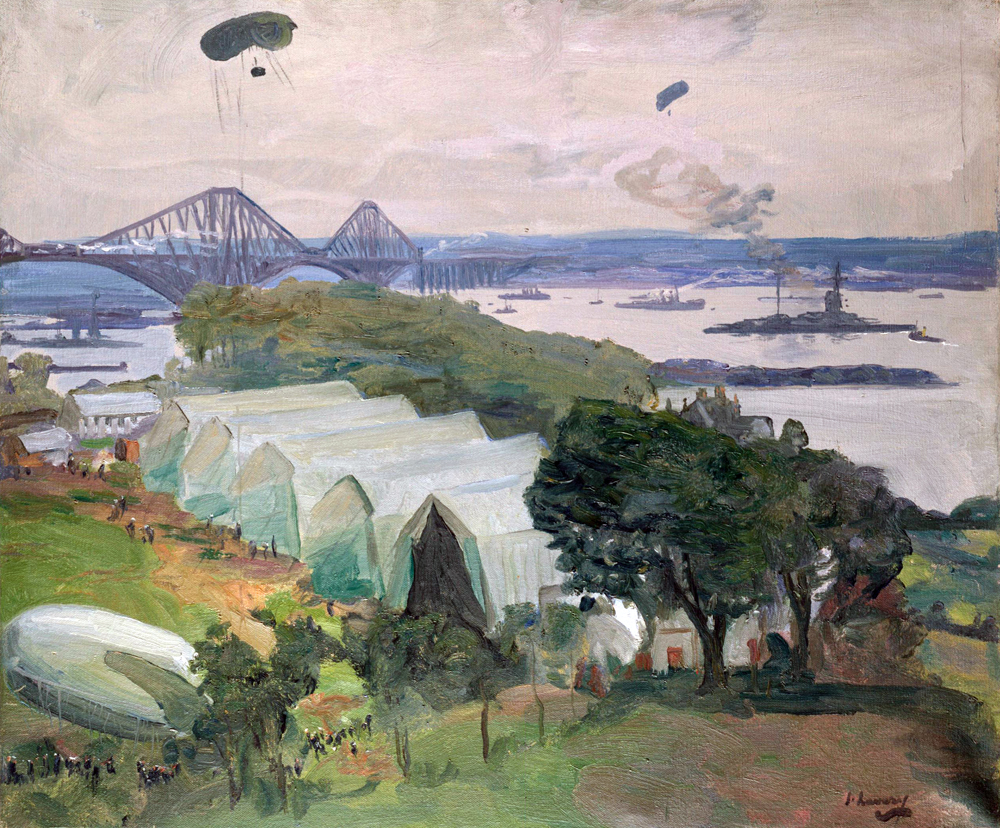 Sir John Lavery’s painting of the Kite Balloon station at Ferry Barns in North Queensferry.
Sir John Lavery’s painting of the Kite Balloon station at Ferry Barns in North Queensferry.
There was another Kite Balloon Station in Methil Docks, but there are no records of its exact location or dates of service.
RNAS Donibristle – naval aircraft maintenance station
Donibristle started life in September 1917 as an emergency landing ground for 77 Squadron, but it was never used in this role. Instead in 1918 it became a naval aircraft maintenance station handling both land-planes and seaplanes – a growing commitment after it was decided to equip all light and battle cruisers with on-board aircraft. The base was to be the principal repair depot for fleet aircraft, the store for reserve aircraft and a landing ground for aeroplanes coming in from their ships.
The seaplane station at Rosyth closed when Donibristle opened.
A railway branch from the mainline provided transport of fuel. This line continued to the shore at Inverkeithing Bay where it ran out onto a pier, providing transport for sea-planes to and from the base. There were two store sheds and a bomb store near the pier.
The base was to be the principal repair depot for fleet aircraft, the store for reserve aircraft and a landing ground for aeroplanes coming in from their ships.
 Donibristle air station, Fife. The landing ground, with the technical buildings and accommodation, to the NE, was linked to the seaplane landing pier, at the SW, by a dedicated railway, on which the seaplanes were transported.
Donibristle air station, Fife. The landing ground, with the technical buildings and accommodation, to the NE, was linked to the seaplane landing pier, at the SW, by a dedicated railway, on which the seaplanes were transported.
(TNA AIR 452/15/312/26 vol 5)
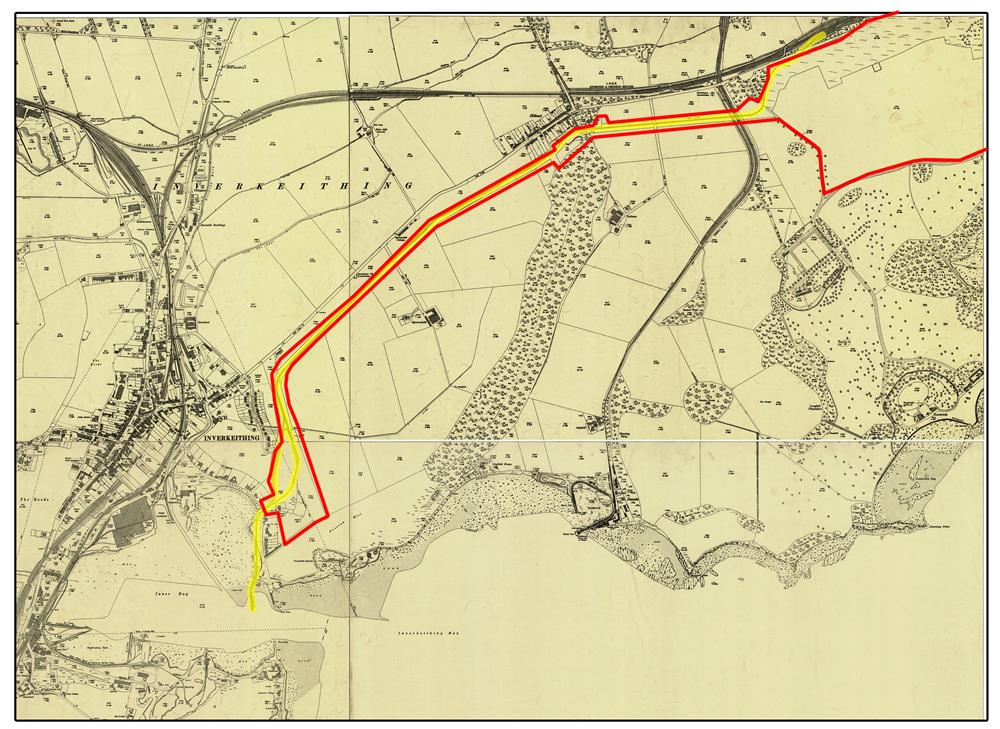 1927 OS map with the railway branch line highlighted in yellow, and Donibristle Airstation boundary from the map above drawn in red. This shows the location of the mooring pier in the Inner Bay of Inverkeithing Bay.
1927 OS map with the railway branch line highlighted in yellow, and Donibristle Airstation boundary from the map above drawn in red. This shows the location of the mooring pier in the Inner Bay of Inverkeithing Bay.
By 1918, the main station covered an area of 53 hectares (measuring 1005m by 550m), with technical buildings in its north-west corner and the accommodation area in the north-east. The technical area included four aeroplane sheds measuring 61m by 30m and an erecting shed and a stores shed of the same size; a further, smaller stores shed, and a range of workshops and ammunition stores.
RNAS East Fortune – coastal patrol station
Although not officially opened as an RNAS station until August 1916, flying had begun at East Fortune the year before. The airfield was used by a number of fighter aircraft during the First World War but is primarily associated with airships at this time. East Fortune’s geographical position near the mouth of the Forth made it very suitable for coastal patrols. Avro 504 and Royal Aircraft Factory BE2c aircraft were among the fixed wing types that carried out this role from East Fortune.
After being commissioned as RNAS East Fortune in 1916, the first airships began to arrive. Non-rigid Coastal Class followed by North Sea Class airships were the first, before the more famous rigid R series appeared. The R.24 was based at East Fortune from 1917 and the R.29 from the following year.
 N.S. 7 and N.S. 8 North Sea class airships – note the crew crossing the walkway from the main cabin to the engine gondola!
N.S. 7 and N.S. 8 North Sea class airships – note the crew crossing the walkway from the main cabin to the engine gondola!
 R24 at East Fortune
R24 at East Fortune
Two large airship sheds were built in 1916 before a third followed to house the rigid airships in 1917. These huge buildings were dismantled in 1922.
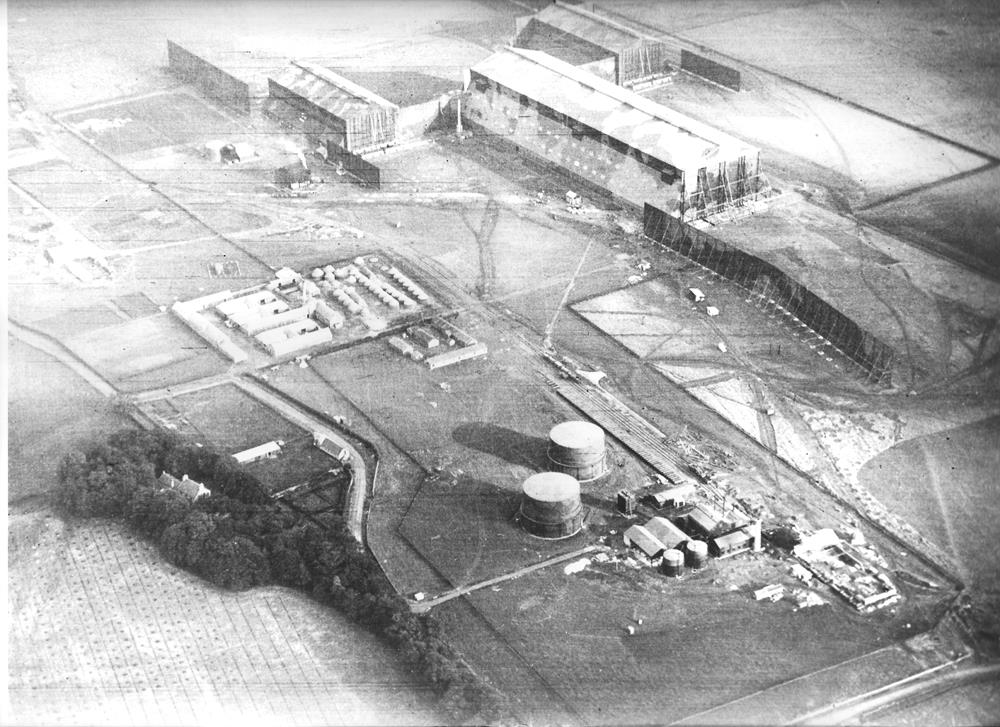 East Fortune – airship sheds at the top, and gas generation and storage at bottom right.
East Fortune – airship sheds at the top, and gas generation and storage at bottom right.
IWM video of R24
The Imperial War Museum has this video of R24 test flights at Inchinnan.
Torpedo Training School
After the formation of the RAF in 1918, East Fortune became home to various quickly retitled units and operated as a Torpedo Training School, using a number of aircraft types. This included the Sopwith Cuckoo, the first aircraft carrier based aircraft capable of dropping torpedoes.
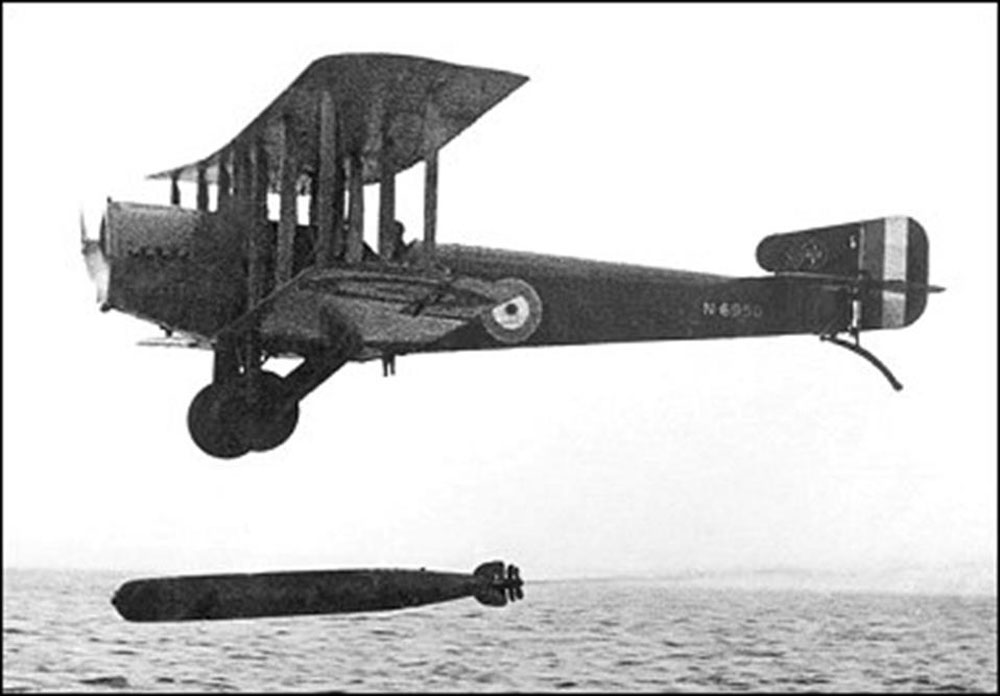 Sopwith Cuckoo
Sopwith Cuckoo
Sopwith Cuckoos from East Fortune practised torpedo dropping at Belhaven Sands
Both the airship station and torpedo training school closed in February 1920 and flying at the airfield ceased.
Back to Military Aviation round the Forth in WWI
top of page
